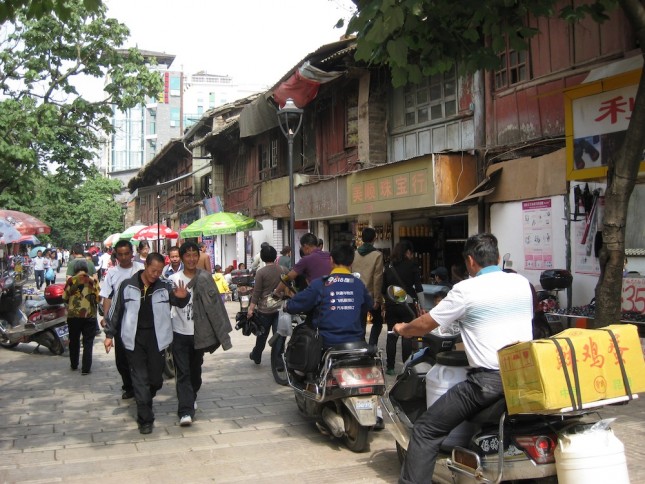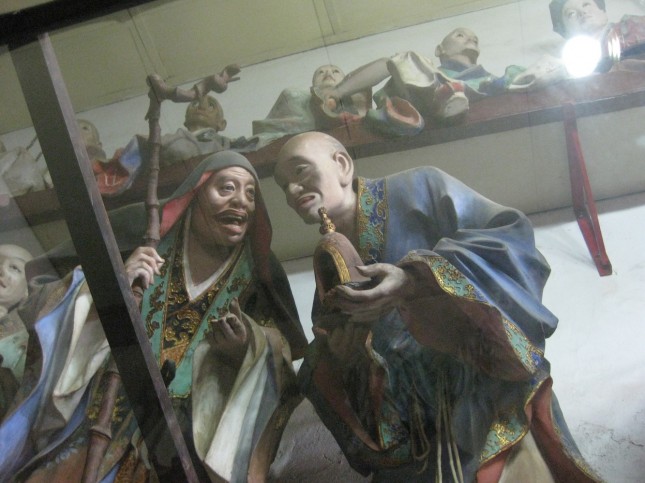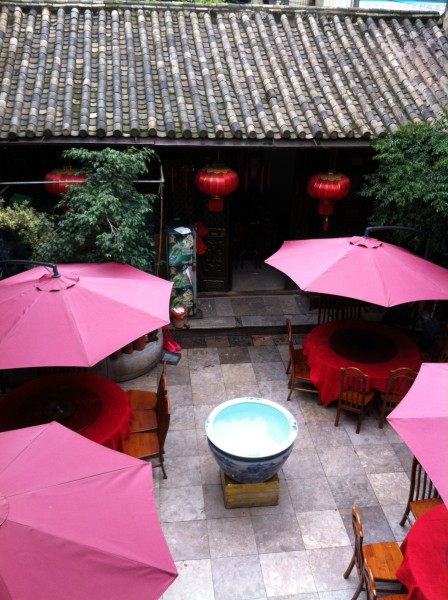Travel in Kunming
March 22nd, 2013

Yunnan’s capital city is in many ways just another Chinese city, with many of the same mega apartment complexes, giant malls, and chain stores as every other city in the country, but it is also a particularly pretty version of a Chinese city, with flowering trees and huge cascades of bouganvillias hanging off of the buildings, especially along the quiet streets near Cuihu park. It’s not worth staying more than a couple of days in Kunming, but there are some nice sights.

Statues of Arhats at the Bamboo Temple
Sights:
If you’re going to do just a few things in Kunming, the Bamboo Temple (筇竹 寺, “Qióngzhú Sì”) is a highlight. Located at the top of a nearby mountain, it boasts dozens of amazingly expressive carvings of arhats (highly enlightened Buddhist practitioners), lovely gardens, and a little restaurant serving very nice vegetarian dishes and high-quality tea.
Evening in Green Lake Park: One of the city’s central gathering points, this lovely, traditional garden (翠湖 公园,”Cuìhú Gōngyuán”) is particularly fun to visit in the evening, after dinner, when local women get together to do a line-dancing-like form of exercise, amateur musicians practice together, and families take a post-prandial walk. During the day, there are also some lovely tea houses in the park where you can sit and enjoy the city’s famously temperate weather.
The historic Bird and Flower Market: Though this little grouping of streets has become more of a tourist draw than the original market (which existed on a street now undergoing construction and consisted of vendors selling animals), the Bird and Flower Market (花鸟 市场, huaniao shichang) is still an excellent place to browse for tsotchkes and see all kinds of beautiful birds, tiny baby rabbits, kittens, puppies, lizards, flying squirrels, and many other kinds of animals the Chinese like to keep as pets. When you’re done looking at the things sold by the vendors on the streets, try the building that has lots of aquarium equipment on the ground floor; the second and third floors are full of shops selling beautiful jewelry and handicrafts.

Lao Fangzi Restaurant
Restaurants:
“Old House” (老房子, Lao Fangzi), is one of the city’s most famous restaurants and does very nice versions of many local Yunnanese specialties. It is located a few yards from the Bird and Flower Market, in the only old Kunming-style courtyard house still standing in the city, and has a very helpful menu with pictures and English. A good place for tourists but also a good restaurant. Address: 18-19 Jixiang Xiang, Dongfeng Xi Lu (东风西路吉祥巷18-19号) Phone: (0871) 3644555
1910 La Gare du Sud (火车南站, Huochi Nan Zhan), is a beautiful restaurant located in the city’s old southern train station (hence the name “South Train Station”). The restaurant does lovely, upscale versions of local Yunnanese dishes and is a wonderful place to host a celebration or take visiting guests. Their fried local cheese, which comes with a bowl of sugar to dip it into, and their braised rib, which comes layered on the bone, are particularly good. Address: 8 Houxin Jie (后新街8号) Phone: (0871) 3169486
Yingjiang Dai-Flavor Restaurant (盈江傣味园, Yinjiang Daiwei Yuan), is one of our favorite places to eat. It’s an unassuming restaurant on our block that serves amazing Dai food like great grilled pork belly, spicy eggplant and bell pepper salad, rice noodles with a lime-cilantro dipping sauce, stir-fried banana flowers, Chinese watercress cooked inside banana leaves, and pork with water pickles. Everything on the menu is delicious (if usually quite spicy). Address: 67 Luofeng Jie (螺峰街67号) Phone: (0871) 5122251 Look for the green bamboo on the front of the building. They also have a branch a few blocks away, next to the park: 66 Cuihu Bei Lu (翠湖北路66号) Phone: 13888776999 And they have a noodle stand on Luofeng Jie, a few yards down from the restaurant (look for the bamboo wallpaper); they only serve breakfast and lunch, but the “za jiang” er si and the 西豆粉拌饵丝 (xidoufen ban ersi) are amazing.
Native Foods Restaurant (土生食馆, Tusheng Shiguan), can be tricky to find, but the food is worth it. The restaurant is a kind of experiment in community supported agriculture, supporting a couple of farming villages in nearby parts of Yunnan where they’re trying to develop organic practices. They don’t speak English (or have an English menu), but you can point out things you like eating and see what other people are having. Their cold dishes (凉菜) are lovely (especially if you go in the spring when they have Chinese toon – 香椿, “xiang chun”); their house-made dried tofu skin is fantastic stir-fried with tomato and peppers; and they do a fantastic stir-fried er kuai, especially if you get the version with pork belly. Address: Inside the 1919 Complex at 15 Jinding Shan Lu (金鼎山路15号) on the western end of Jindingshan Lu, near that intersection with Xuefu Lu; the street numbers are not in any organized order. Phone: (0871) 5420010
Hotels:
We have stayed at Lost Garden, a local hostel run by a westerner, many times, and they their rooms are homey and affordable. The staff also speaks English, and they serve western food. Most recently we stayed at the Ji Hotel, and we really loved it. It’s in a convenient location, it’s a few yards off the street, and it had a lovely modern but natural aesthetic. (I should note that the staff doesn’t speak English, but if you have a guide helping you out already, or just a little bit of Mandarin, it’s a wonderful option for $100/night or less.) We’ve never stayed at the Green Lake Hotel, but it’s the most famous hotel in town, and though it’s a much pricier option (rooms start just under $200 per night), it looks pretty nice, and it’s in our favorite part of town. For a really nice hotel, the city is scheduled to get a Sofitel in 2014.
Transportation:
The new subway lines opened recently, and they’re incredibly modern and convenient. You might have a hard time figuring out what station you want to go to (they’re not exactly named for the intersections they’re on), but once you do, there are easy maps, indicators in the trains to tell you which station you’re at and what’s coming up, and even English announcements. Kunming residents also get around by electric bike, bus, and taxi. We usually find taxis to be the most expedient, but for bus travel we use the MapBar iPhone app. It’s all in Chinese, but you can type addresses in in pinyin (the Chinese romanization), and sort of figure it out from there. Google maps can also be helpful, but their route information is not up-to-date.
Photos: Georgia Freedman (3)



